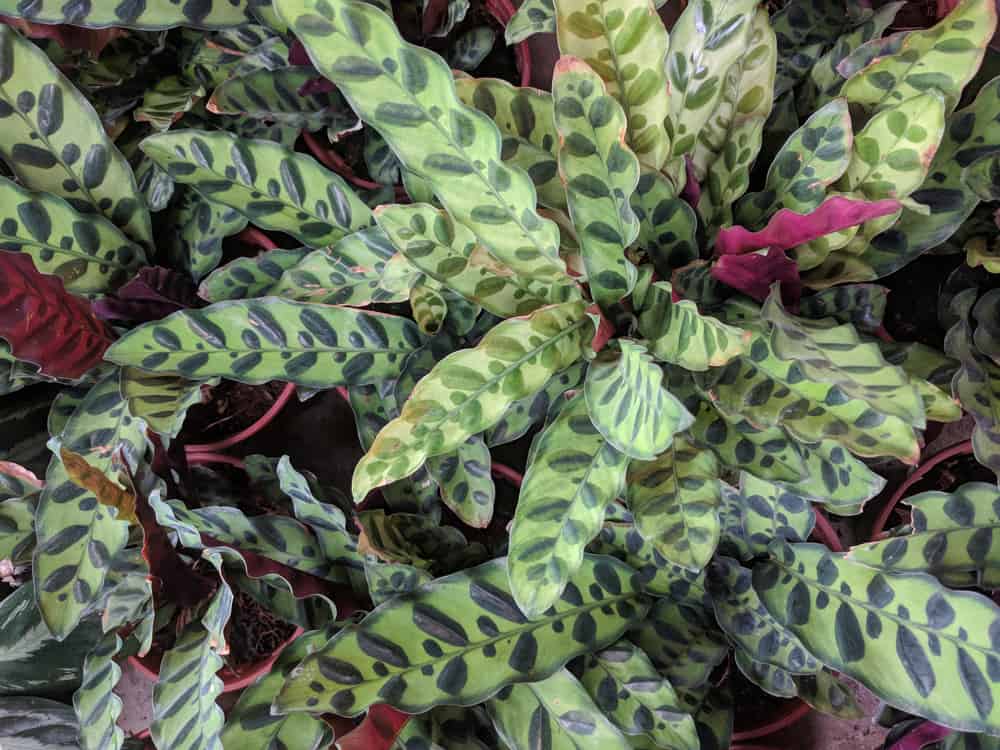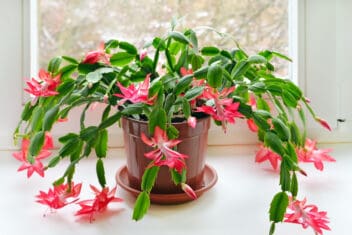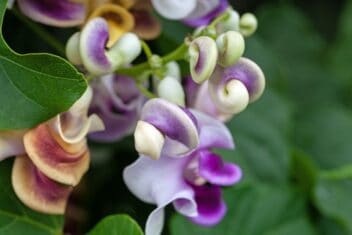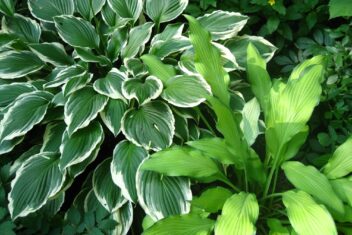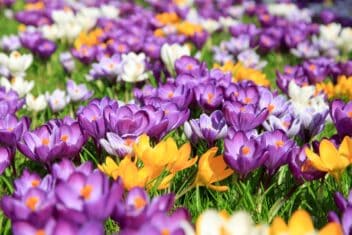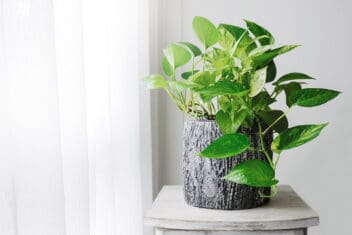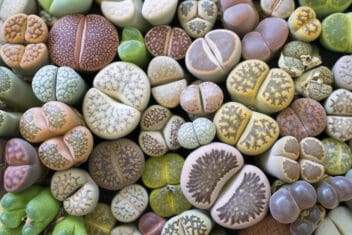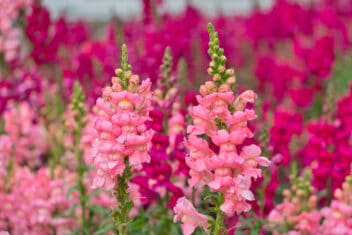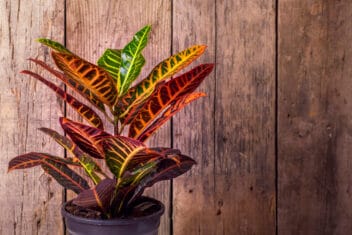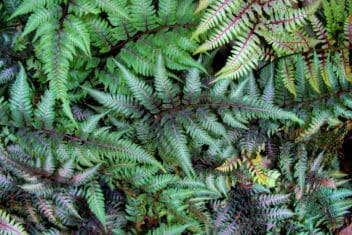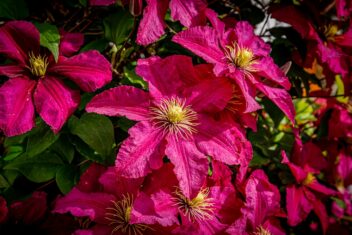I don’t know of any plant that looks as cool as the rattlesnake plant, with the striking, rippled purple and spotted green leaves. Growing rattlesnake plants is a bit of a challenge when it comes to heat, humidity, and moisture. But the extra effort is worth it when you’re enjoying the unique foliage.
It’s usually grown as a houseplant, but you may see it outside in Hawaii, Florida, and Puerto Rico in shaded areas. It is a native of Brazil, after all, and it loves humidity and heat.
If you think this is one of the coolest plants you’ve come across, read on and learn all about the rattlesnake plant.
What is Rattlesnake Plant?
Rattlesnake plants (Calathea lancifolia), also called zebra plants, are native to Brazil where they thrive in the understory of the rainforest. They have long, variegated leaves and the plant can reach 30 inches in height, if not more.
The eye-catching leaves have wave-like rippling and spots of dark green on a medium green base on the upper side. The underside of the leaf is a deep reddish-purple.
Rattlesnake plants rarely bloom indoors, but in their natural environment, they produces small yellow flowers.
Rattlesnake plants are one of many Calathea genus, which also includes peacock plants and jungle velvet. Plants in this genus are a bit particular about their humidity, water, and sunlight, so they aren’t ideal for beginners. Still, if you’re prepared to put in some work, they’ll reward you with a showy display.
To top it off, rattlesnake plants aren’t toxic to cats and dogs like many houseplants. The leaves are even used to wrap food in Brazil, much like banana leaves.

How to Grow Rattlesnake Plants
You can grow rattlesnake plants in shaded spots outside in USDA Growing Zone 10 and above. Below that, you have to grow them inside.
The optimum temperature is 65ºF to 85ºF, so think about where in your house you will place this plant. Any lower than this for long periods and you’ll see drooping leaves and browning of the plant, especially with sudden or sustained temperature drops.
Indoors
Rooms or areas of the house need to be between 65-85ºF. Don’t place it next to an AC vent where it will get a constant cold breeze.
These plants do best when they have bright, indirect sunlight. A little direct light in the morning is fine, but in the heat of the afternoon sun, they must be shaded.
Unlike some house plants, rattlesnake plants can be a little fussy with their soil requirements. It must drain well, but hold moisture. Use a good quality potting mix and add a little sand to improve drainage. If you make your own potting soil, be sure to include perlite or rice hulls to help retain water, but use sand to increase drainage.
Avoid alkaline potting mixes. Neutral or slightly acidic soil works perfectly. This means the pH should be below 7.0.
Humidity is going to be your best friend when it comes to growing rattlesnake plants. You can use a misting bottle each day, but the best method is to place a tray filled with pebbles and water under the pot holding the plant. When you water, the draining water will sit there and provide the humidity rattlesnake plant craves.
You can also increase the humidity naturally by placing plants close together.
Take your plant to the shower with you. Of course not in the shower, but rattlesnake plants will benefit from the steamy, humid environment of a bathroom.
Feed with a balanced fertilizer made for houseplants once a month in spring and summer. Feeding monthly in those two seasons will give you the healthy-looking, strong foliage you want.
If your house gets hot in the summer, make sure you water enough to keep the soil moist but not wet. You know a sponge when you wring it out really well? That’s what you’re aiming for. In the winter, allow the top inch to dry out before watering again.
Depending on what chemicals are added to your water supply, you may need to age your water or use filtered water. This includes water for misting. If your municipality adds chlorine, you can set a container of water out overnight to allow the gas to evaporate.
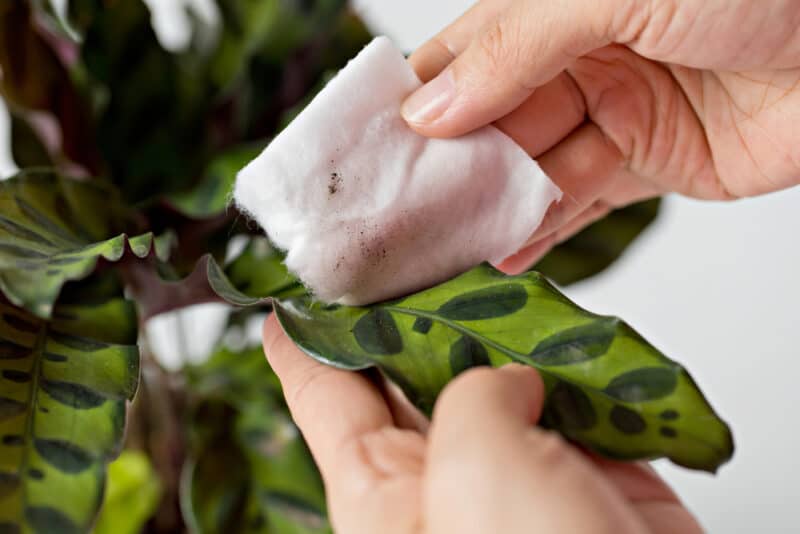
Dust your rattlesnake plants regularly. This keeps the foliage and plant as a whole healthy. Use a very soft, damp cloth.
Repot your rattlesnake plant every two years or so. You may need to do it more often if the plant is a vigorous grower. Take this opportunity to divide the plant for more to pot up.
Outside
In its natural environment, you’ll never see rattlesnake plants growing in direct sunlight. They will struggle and die if you don’t place them in part shade or dappled light, with protection from the afternoon sun.
Areas that experience sudden temperature drops or cold winds can’t support rattlesnake plants. If the temperature drops below 65ºF, you should plant the rattlesnake plant in pots so you can move them inside when necessary.
If you plant more than one rattlesnake plant, space them 18-24 inches apart.
Fertilize outside rattlesnake plants four times in spring and fall. Use a balanced fertilizer and water in well. Avoid watering in the evening.
Mulch in the hottest part of the year to retain moisture in the soil.
Propagating Rattlesnake Plant
You can propagate rattlesnake plants by taking cuttings of existing plants or by dividing mature plants. Both work very well.
Division
Make sure you don’t divide a rattlesnake plant that has been sitting in dry soil. This stresses the plant and might even kill it. Water well the day before you divide so there is moisture in the soil.
- Choose a pot bigger than the root ball of your divided plant. Make sure there are drainage holes in the bottom.
- Using two parts peat moss and one part perlite, fill the container up 1/3 of the way.
- Tip the existing plant on its side and slide it out of the container. Brush some of the potting mix or soil away and look for where the root ball naturally wants to come apart. Gently pull the sections apart, but don’t force it.
- Once pulled apart, look for damaged or diseased roots and trim them off. If I have a rattlesnake plant with lots of roots, I will sometimes give it a haircut by trimming them all lightly, though it’s not necessary, especially as it’s just been split.
Cuttings
Use a very sharp set of cutters or a knife for this project.
- Choose a leaf that isn’t old or too young.
- Cut it off cleanly at the bottom.
- Place the leaf in a container with just enough water to cover the bottom fourth of the leaf.
- Change this water every second or third day.
- The container should be in a light, warm place out of direct sunlight.
- Place a plastic bag over the container if you don’t see roots forming in a week and a half.
- Once the roots are strong, plant in a small pot with the peat moss and perlite mixture.
You can also root a cutting in a seed-raising medium. Once you cut the leaf off, let it start to dry or callus at the cut for two days before planting it in moist medium. The plant should root and begin growing in about two to three weeks.
Common Problems and Solutions for Growing Rattlesnake Plants
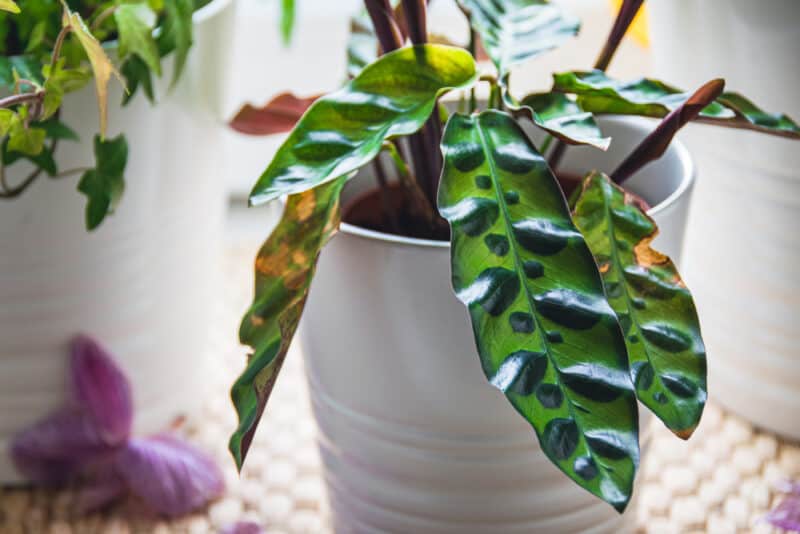
Let’s start with some appearance issues that usually signify a problem that can be solved.
Leaf Pattern or Color Fading
One of the coolest things about this plant is the pattern on the leaves, so you certainly don’t want it to fade. This is normally caused by too much direct sunlight. Simply move it to where there is indirect light.
Edges of Leaves Turn Brown
This often means humidity is lacking in the plant’s environment. If the air in the house is too dry, the leaves may go brown or curl up at the edges. Add humidity through a misting bottle, or by placing a tray of pebbles under the container holding the plant.
Stems Go Limp or Rot
This is likely caused by overwatering or an environment that is too cold. Move the container to a warmer area and protect the plant from temperature fluctuations. Take care not to overwater.
Leaves Dry and Fall Off
This is a sign of a dehydrated rattlesnake plant. If the whole plant is crisp, cut the entire plant about an inch above the soil. Water well and cover with a transparent plastic bag with holes in it. Keep the soil moist. When you see new growth, keep the bag on for another month.
New Leaves are Faded Light Green Compared to Older Leaves
This is probably a lack of nitrogen. Give your rattlesnake plant a good feed of fertilizer. Use a balanced feed, but you may need to use one rich in nitrogen until the color comes right on new growth.
Aphids
Most houseplants are susceptible to aphids. We have a guide on aphids on garden plants and how to spot them. Use insecticidal soap or neem oil on a regular basis.
Spider Mites
Spider mites can cause a lot of damage in large numbers. The thick, fleshy leaves are very attractive to these pests. Read our article on spider mites here.
